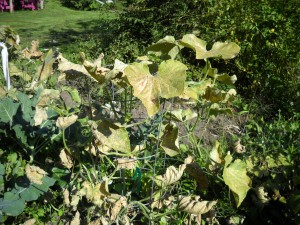Putting The Garden To Bed
Just last week that I was planting tomato and pepper seedlings – or so it seems. But now the big yellow buses are out there each morning, delivering the next generation of gardeners to school, and there is a definite nip to the air when I go to get my newspaper out of the box in the morning. Where has the summer gone? It’s time to start thinking about putting the garden to bed.
This is the time of year that weeds take advantage of us. Most of us tend to be lackadaisical about weeds now that our vegetables have produced, our flowers have bloomed, and our attention has turned elsewhere (school, football, presidential debates). But if you want to reduce your work next year, pay attention to those weeds that have snuck into the garden: they are producing seeds that will lie in wait for the spring, ready to grow before we get the good plants established.
I hereby resolve to spend a minimum of 20 minutes every day weeding for the rest of September. If I do that, I shall save myself much aggravation next spring. Here are a few things to consider when you weed. First, weed when the soil is moist – you are much more likely to get out the entire root system. That is very important for perennials weeds like dandelions or witch grass because a scrap of their roots will regenerate new weeds.
Annual weeds pull more easily, and it’s less important to get the entire root. They reproduce by seed, and often produce hundreds, even thousands of seeds per plant – and those seeds can stay viable for years. When weeding things loaded with seeds, be careful not to shake off the seeds when you pull the weeds. It means that you can’t shake off all the topsoil that comes out with the roots, but I’d rather avoid dumping seeds into my garden soil- even if I lose some.
I also try to place seed-bearing weeds in a compost pile that I will not use any time soon. In fact, I have compost piles where I dumped problem weeds decades ago. I let it turn into soil and use it for fill dirt– but not in my vegetable garden. After all, I heard that King Tut’s tomb had weed seeds that were still able to germinate, though that may be just a myth.
I am also conscious of erosion when weeding and removing annual plants in the fall. I think it’s better to cut off the stem of big zinnias, for example, than yank them now. That way I am not opening up the soil, making it vulnerable to erosion or providing a nice resting spot for air-borne weed seeds. Many weed seeds are tiny and can blow in from your lazy next-door neighbor’s garden. I can always dig out roots in the spring when I plant something else, and they may decay and add some organic matter to the soil in the meantime.
In the vegetable garden it is important to get rid of diseased or insect-infested plants. You shouldn’t put them in the compost, either. Put them on the burn pile if you’ll be burning brush this winter, in the household trash, or in a pile far from the vegetable garden. This will help to minimize the recurrence of problems. That goes for moldy phlox or other flowers that get diseases, too.
If you have an asparagus patch, look to see if your plant are loaded with those little “berries”, their seeds. If you see seeds, cut down the stems before winter. Some of those seeds will settle in and start more asparagus plants, but you really don’t want more plants – they will fight for moisture and minerals just as weeds do. Most asparagus plants sold now are in the “Jersey” series and are all male, so they bloom but do not produce seeds. But one of the 25 plants I put in this year was a female, so take a look at yours now and cut down any with berries. And for best production, get out any weeds this fall.
I like to prepare my vegetable beds in the fall. After weeding them, I re-shape my mounded raised beds and add some compost or aged manure. Then I cover them with chopped fall leaves and grass that I rake up after mowing. This stuff does not blow away as you might imagine – one good rain storm and it settles down for a long winter’s nap.
Fall is a good time to spread some limestone on the lawn, or to your vegetable and flower gardens if your soil pH is acidic. Most things grow best at a relatively neutral pH, say 6.2 to 6.8, but what with acid rain, many of us have soil that is pretty acidic. This is a good time to get a soil test done and make adjustments as needed. It takes time to adjust soil pH, so working on that now will make the soil better next spring.
There is so much to do in the garden, week after week. It’s important not to just throw up your hands and say, “I’m done!” Yes, fall is here. But don’t stop gardening – everything you do now will help make next year’s garden even better.
Henry Homeyer is the author of four gardening books and a new children’s book just out called “Wobar and the Quest for the Magic Calumet”. Check for Wobar in your local bookstore or go online to henryhomeyer.com to learn more about the book.



